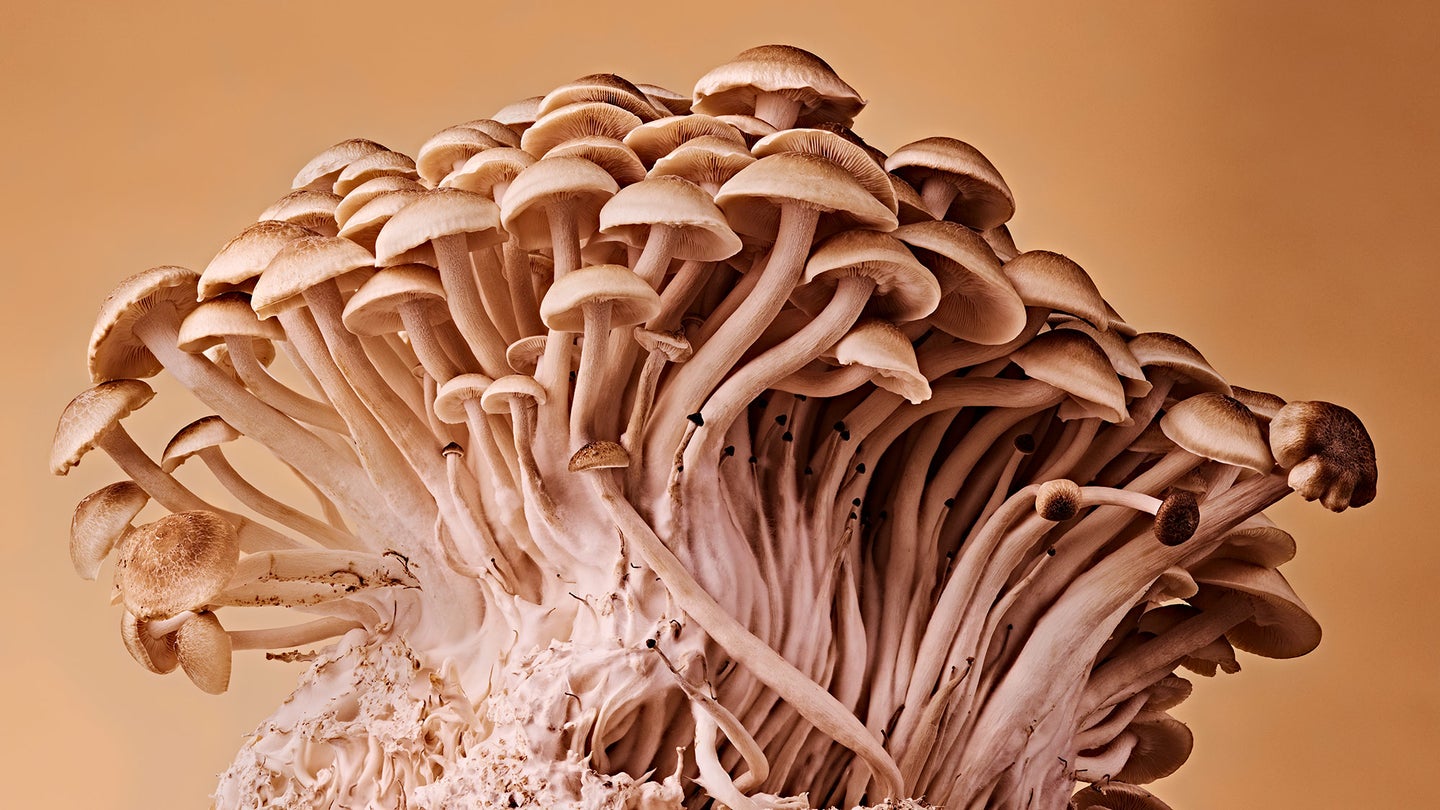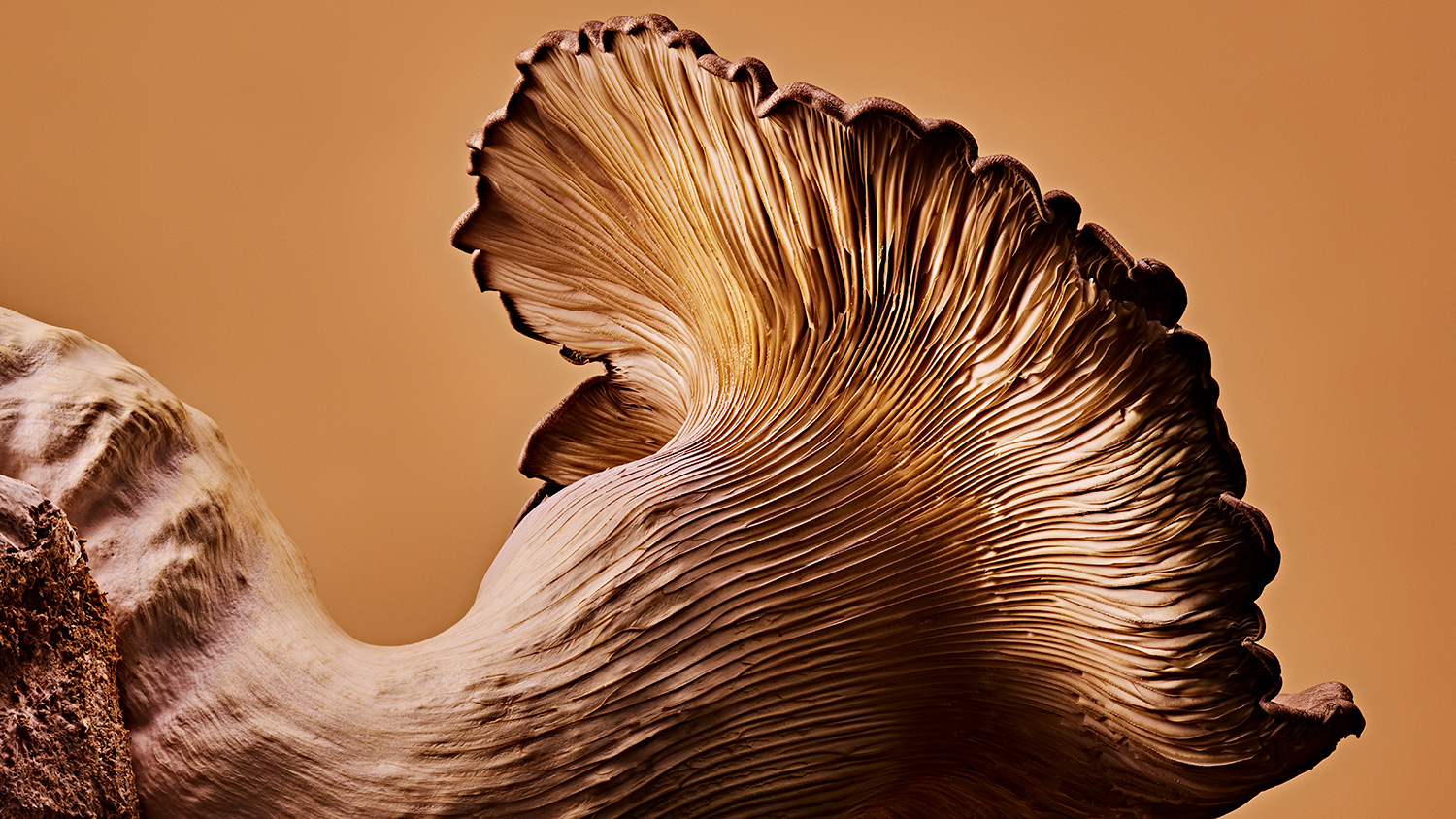
How to use the power of mushrooms to improve your life
Enter the worlds of mushroom dyeing, mycotecture, and more.
YOU’RE WALKING through a forest. The soil is soft beneath your feet, and the sun is shining brightly through the dark green treetops. To your left, you see rotten logs with dense clusters of oyster mushrooms. On your right, a thick bundle of chanterelles sprouts from the leaf-littered floor. Farther off the beaten path are stout-looking porcinis, frequently with a colony of poisonous fly agarics nearby, and, maybe, a bunch of magic blue gyms—those might ruin your nature walk, though.
The mushroom kingdom holds many shapes and secrets beyond those of the little white buttons and baby bellas found at the grocery store. Ethical foraging is one of the easiest and most valuable ways to incorporate an array of mushrooms into your life; to get started, you can join a mycology group or contact a local guide to learn how to harvest edible fungi safely and sustainably.
But there are more creative ways to incorporate the power of mushrooms into your days. Fungi are a versatile and adaptable group, which is why they offer a range of benefits to a variety of people. They’re a multifaceted food source, providing fiber, protein, and other nutrients. They can be used to create dyes, build structures, or breed new strains of mushrooms. In essence, they’re really cool, and they’re inspiring biologists, artists, and engineers to develop practices that can make the world prosper. Here’s a mini-tour of what the flourishing field of mushrooming has to offer.

Shopping for mushrooms
Head to the supplement aisle in any health food store, and you’re bound to find shelf space dedicated to the medicinal wonder of mushrooms. Research on fruit flies and mice shows that cordyceps, popular among consumers (and apocalyptic TV shows), has anti-cancer properties and possibly anti-aging effects, too. Reishi and turkey tail are coveted for their potential immune-stimulating effects, while lion’s mane may help soften dementia, according to a small pilot study.
Most of these benefits have been investigated on animals or in test tubes, making it challenging to draw conclusions on human health. If you’re looking for guaranteed results, it’s better to grab fresh, whole mushrooms from the produce section than spend all your money on pills and potions.
“Eating food is always safer and less expensive than using its supplemental form,” says Lori Chong, a registered dietitian at the Ohio State University Wexner Medical Center. With fungi, you should know which edible varieties are good to cook with. Reishi and turkey tail are not commonly used for culinary purposes because their tough texture and bitter taste make them unpalatable. On the other hand, lion’s mane, shiitake, enoki, and maitake make fine ingredients for a meal, each with its distinct flavors and properties.
A steady intake of mushrooms can work wonders for our bodies. Eating 18 grams daily could reduce someone’s cancer risk by 45 percent, according to a scientific review of 17 observational studies. Using mushrooms to lessen meat consumption can also help reduce the risk of heart disease by lowering saturated fat in a diet—you can do this by mixing chewy stems and caps with ground meat. And they’re one of a few sources of ergothioneine, an amino acid with anti-inflammatory effects, according to several international medical papers.
Getting them into your diet isn’t too difficult, says Chong. “Mushrooms make a great addition to any combination of stir-fried vegetables,” she explains. “They are easy to prep and quick to cook. Consider sautéing a package of mushrooms and keeping them in the refrigerator to add to an omelet, spaghetti sauce, sandwich, or salad.”
Oh, and don’t eat them raw: Farmed mushrooms may contain agaritine, a toxic compound destroyed by heat during the cooking process. Research has found that certain store-bought varieties have less agaritine than freshly picked ones, but questions remain.
When shopping for whole mushrooms, make sure they’re firm to the touch, smooth, and dry on the surface. You don’t want any that look dried out, feel slimy, have big spots of discoloration, or show wet spots. Once you get home, store them in the fridge in a loose bag or a glass container with the lid cracked to prevent moisture buildup and fast spoilage.

Dyeing with mushrooms
Though they’re certainly delicious, there’s much more you can do with mushrooms than eat them, including making pigments for fabric dyes, ink, and all varieties of paint. In fact, the vastness of the fungus kingdom covers every color of the rainbow, says Julie Beeler, a naturalist, teacher, and artist. “Mushrooms contain a variety of different chemical compounds that create colors ranging from red to yellow to blue and colors in between,” says Beeler. “These pigments can be found throughout the mushroom, but for certain species like Cortinarius semisanguineus [the surprise webcap], the color is concentrated in the caps. For Hydnellum caeruleum [the blue and orange hydnellum], the color is throughout the mushroom. And for Hypomyces lactifluorum [the lobster mushroom], it is only the parasitized outer layer.”
Beeler created the website Mushroom Color Atlas as an educational resource for people who want to use mushrooms to make hues. She walks beginners through the process of extracting dyes from 28 fungal varieties that are common in the wild, and she intends to add another 13 in the coming months. Those few dozen specimens can produce more than 800 colors, she notes.

While the practice is growing in popularity, it has centuries of history. Fungi, particularly lichens—complex organisms created by a symbiotic relationship between a fungus and an alga—have been used in cultural practices across North America, North Africa, Asia, and Europe. Prior to the Industrial Revolution, all pigments were processed naturally. Since then, pretty much every dyed item we encounter has been colored using synthetic dyes. “Mushrooms allow you to get back to natural practices that are more regenerative and sustainable for the environment and the planet as a whole,” says Beeler.
To stain fabrics, she explains, you need a pot, similar to one for making tea. Beeler suggests cutting the fungi into smaller pieces and steeping them for about an hour in hot, but not boiling, water. (A temperature of about 160 degrees Fahrenheit will prevent the compounds from degrading.) When the color of the water has changed, you can dip natural fibers in to dye them.
The look of your final product will depend on the mushrooms you use and your material. Wool tends to absorb more vibrant, bolder shades from the organisms than other textiles. Cotton, the world’s most widely used fiber, is surprisingly more complicated because it’s cellulose-based and requires a lengthier mordanting process to fix the chemicals to the threads. “You’ll need to be a lot more advanced to get really great colors on cotton,” says Beeler, “but you can get some incredible colors with wool.”

If you’re not getting the look you want, you can alter the pH of the dye bath depending on what the mushroom you’re working with responds to best. Certain species prefer more acidic environments, so you can add vinegar to produce an orange tinge. Or for greater alkalinity, add a sprinkle of sodium carbonate to get a vibrant blue or green. The hues might fade over time with repeated washing or exposure to sunlight, unless you use a mordant like alum to bind them to the fibers.
The best part is that you can find your main materials almost anywhere: while moving dead limbs around your yard, during a walk through the park, or perched upon a strip of grass in a parking lot after a good rain. Some will look like the mushrooms you get from the grocery store, with the expected gills underneath; others will have more novel structures. Boletes, such as the spring king, have a spongy cap and produce a range of beautiful earth tones. Some false gill mushrooms deliver a spectrum of blues, greens, and yellows, depending on which you grab. Tooth fungi have fanglike spines and often produce blues or greens. Another excellent clue to the dyeing potential of a mushroom is whether it’s colorful inside and out. The lobster mushroom, for example, makes a variety of pinks and reds, true to its name.
“I just love that as I’m walking in different environments, every step I’m taking, I’m thinking about that fungal underground in the soil and the mycelium, this web of connections creating a rainbow beneath my feet,” Beeler says.

Building on mushrooms
Creating structures with mycelium—the network of fungal filaments that allows mushrooms to grow aboveground—is an exercise in simulating the layers in natural ecosystems. The practice is a chance to think of the presence of trash as an opportunity to create something new. “In the living world, there isn’t really such a thing as waste,” says Merlin Sheldrake, the author of Entangled Life, a bestselling book on mycology. Scraps are always used to create something else, like a scavenger breaking down a carcass. “Are there ways that we can learn from those cyclical processes to behave more like other living organisms do?” Sheldrake continues. “Or will we continue just to produce stuff and then put it in landfills?”
Building with fungi is a relatively new field that’s in a state of expansion. Mycelium can be used to create packaging, clothing, and even buildings; researchers are working on making the materials more robust and streamlining production. BioHAB, an architectural project in Namibia, for instance, is salvaging the remains of cleared encroacher bush, an indigenous species that drastically reduces usable land and resources, to create a substrate for farming mushrooms. The waste from cultivating the fungi is then compacted into eco-friendly bricks. The end product is strong, flexible, insulative, and soundproof, and can be used to reinforce structures in local villages, BioHAB’s website states.

Similarly, NASA is looking into mycelium-based construction materials for astronaut dwellings on the moon and Mars. These composites are light and transportable, protect better against radiation, could self-replicate in their new environments for an endless resource, and, at the end of their life spans, can be turned into fertilizer.
Working with mushroom structures encourages builders to think about the whole cycle of production. “If you’re growing composite material using mycelium and hemp, for example, then you think about where the hemp is coming from,” Sheldrake explains. “Then you start thinking about the fact that you are harnessing a waste stream from another industry to produce the feedstock to grow the fungus.”
Accessing mycotecture at the consumer level is a bit more complicated, but more opportunities are sprouting up. If you want to wear your mushrooms, luxury fashion houses like Stella McCartney, Balenciaga, and Hermès are experimenting with mycelium leather. In 2021 Hermès introduced a bag in partnership with MycoWorks, a company that develops leatherlike materials in a variety of colors from reishi.

Pivoting to mushrooms could, in part, help buffer the effect industrialization has on the planet. Manufacturing is a major cause of environmental degradation, pollution, carbon emissions, and waste. Mushroom-sourced components can offer a break from petrochemicals and plastics if they can be produced sustainably enough and brought to scale. But the field, which is still in its infancy, has a ways to go before it can make an earnest contribution to the use of sustainable goods.
“These fungal materials are exciting when you step back and look at how all these different industries go together and the possibilities that exist between them,” says Sheldrake. “Unless we rethink the way that we build and produce, then we are going to be in even bigger trouble than we already are.”

Growing your own mushrooms
When Tavis Lynch started raising mushrooms in the early 1990s, he approached it as a hobby before expanding into more complicated projects, eventually becoming a professional mycologist and commercial cultivator. He currently grows 20 indoor and outdoor mushroom varieties employing genetic pairing—creating new strains of mushrooms by mating spores from two existing varieties.
Lynch has made a fruitful career out of something people can do at home. A DIY venture doesn’t have to be complicated. “There are a lot of different ways to grow mushrooms,” Lynch explains. “We can grow them on wheat or oat straw. We can grow them on natural logs. We can grow them on compost. We can even grow them on blended substrates that we create, typically an enriched sawdust or coffee grounds.”
Most varieties of mushrooms bred at home are used for cooking or medicine. But the first thing to assess is the resources available where you live. Coffee grounds, compost, or sawdust will be the best substrates for anyone living in a major metropolitan area where green space is limited or tightly regulated. For those budding hobbyists, going the kitchen counter route with a tabletop kit, rearing specimens in a basement, or even hanging them somewhere in your shower will be your best bet. (Choosing a shaded, humid spot is the most important element.)
Once you’ve figured out the logistics, including what type of mushroom you want to farm, Lynch suggests finding a spawn supplier—a step that, like growing the fungi, won’t be too hard. “They’re popping up left and right every day because the trend toward home cultivation of mushrooms is massive right now,” he says. Companies such as Tavis’s Mushrooms, North Spore, Field & Forest Products, Earth Angel Mushrooms, and Mushroom Queens offer online ordering and quick shipping across the US.
I ordered a pink oyster mushroom kit online from Forest Origins. Starting the growth process was as simple as Lynch had said it would be: All I had to do was cut into the substrate bag, disturb some of the top layer with a fork, dampen it, and place it on my counter to get indirect sunlight. Then, twice a day, I came by and spritzed it with a water bottle. I started seeing fruiting bodies develop about a week into this daily ritual. Sadly, I accidentally sprayed it with bleach while cleaning and had to order another kit.
Bleaching aside, checking on my baby mushrooms felt as good as tending to my other plants. Ensuring they had enough sun and moisture gave me a few minutes of grounding amid chaotic days. It was a reminder that nearly everything provided to us by this Earth is beautiful and useful.
“Getting out, working with your hands, having a distraction from your digital devices and from the noise of others and the city—that’s the real medicine,” says Lynch. “I’m looking out my window right now at my mushroom farm, and I wish I was out there working on it.”
Read more PopSci+ stories.